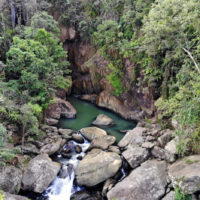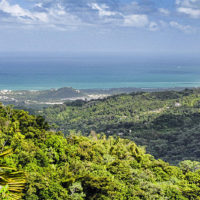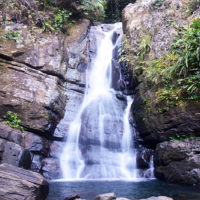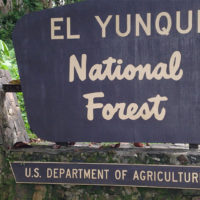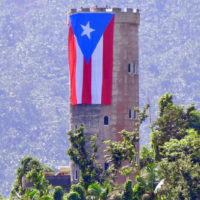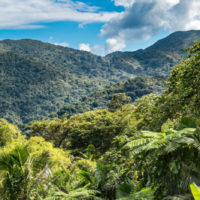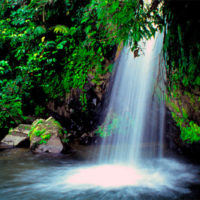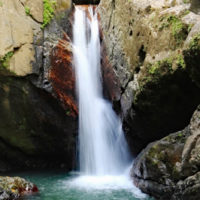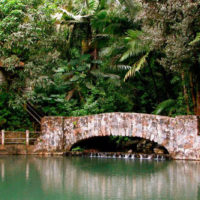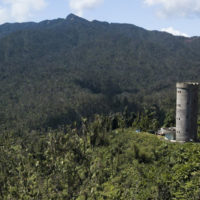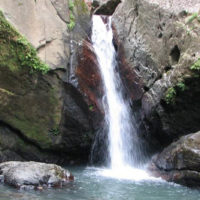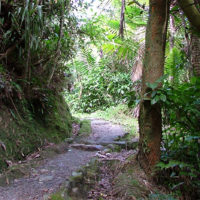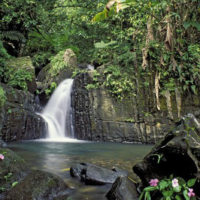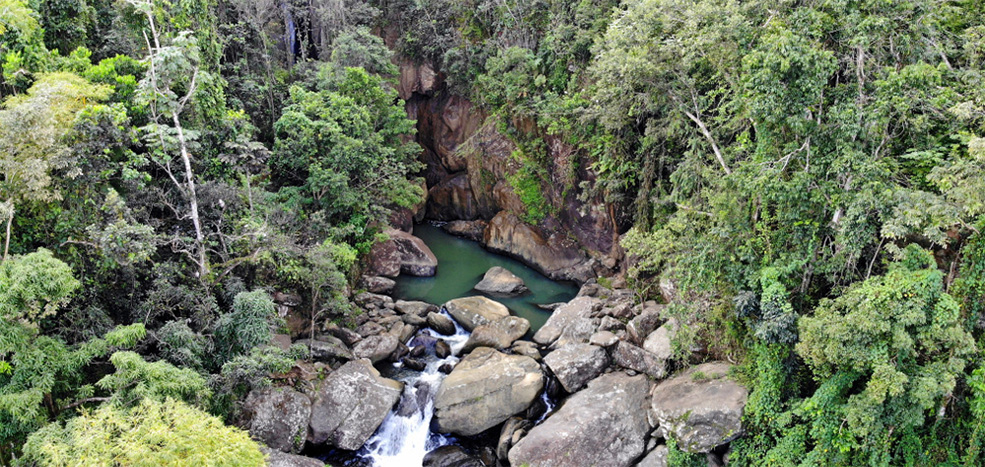
El Yunque National Forest
Río Grande, Puerto Rico
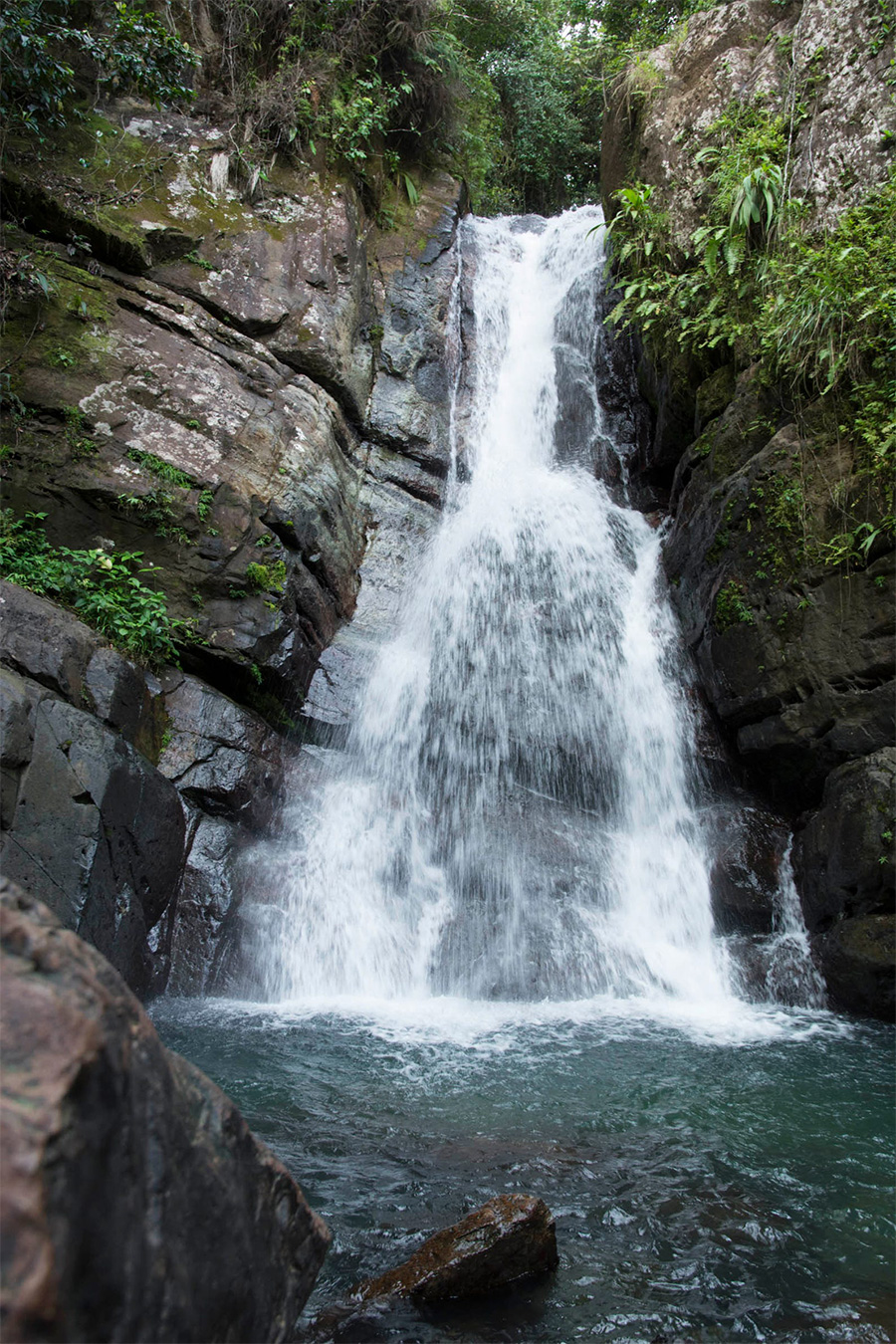
El Yunque National Forest, formerly known as the Caribbean National Forest (or Caribe National Forest), is located in the northeast of Puerto Rico in the rugged Sierra de Luquillo<, 40 km southeast of San Juan (latitude 18°19′N, longitude 65°45′W).
It is the only rainforest included in the United States National Forest System and is managed by the United States Forest Service. Known for its rare trees and birds, it is one of the smallest rainforests but boasts a diverse habitat and is the most biologically rich.
The forest spans the municipalities of Canóvanas, Las Piedras, Luquillo, Fajardo, Ceiba, Naguabo, and Río Grande. It is one of the most treasured natural resources of Puerto Rico and the Caribbean. This dense emerald-green forest covers 29,000 acres, with peaks rising up to 3,494 feet (1,065 m) above sea level.
Abundant rainfall—exceeding 20 feet annually in some areas—creates a jungle-like environment with lush foliage, bluffs, waterfalls, and breathtaking rivers.
The forest offers panoramic views and trails where visitors can appreciate the flora and fauna of this jungle paradise. All of El Yunque’s peaks provide spectacular vistas of the forest, nearby peaks, drifting clouds, and the Atlantic Ocean and Caribbean Sea.
Birdwatching and Wildlife
Birdwatching is just one of the many attractions in El Yunque. Visitors can also explore trails, stunning waterfalls, mountain streams, observation towers, and panoramic views. The forest is home to various wildlife species, including parrots, hawks, frogs, and reptiles. Guided tours are available for those seeking the best spots to observe wildlife.
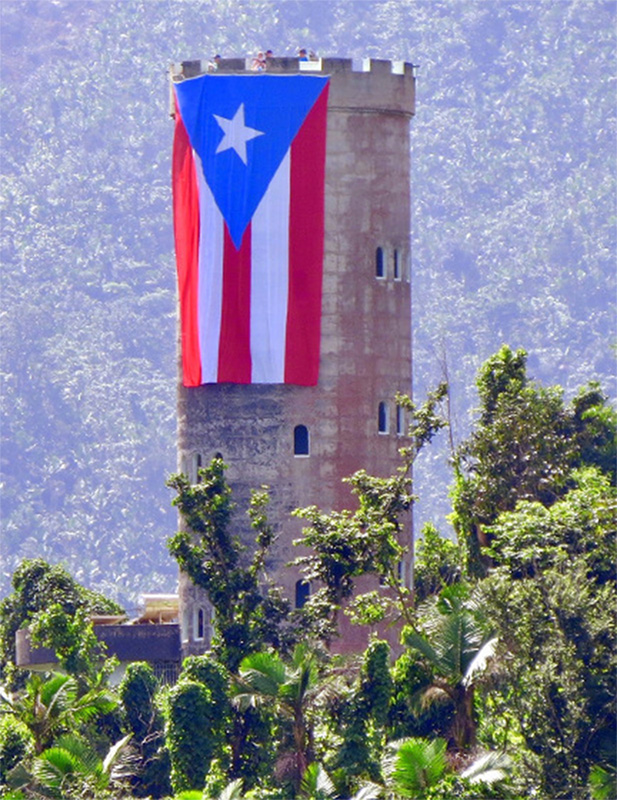
Yokahú Tower and Other Attractions
El Yunque is the most visited attraction on the island and part of the United States National Forest. Most tourists and locals visit as a morning or afternoon trip, often with tour guides. To fully appreciate this remarkable ecosystem, spending at least a full day exploring the misty forest trails and refreshing yourself in its waterfalls and natural spring pools is recommended.
One of the most magical aspects of El Yunque is the opportunity to experience an authentic rainforest. A short hike on paved trails leads to breathtaking waterfalls, where visitors can enjoy the lush plant life, fresh air, and the sounds of birds and the unique coquí (tree frog).
Another hike, less than a mile long, takes you to the summit of Mount Britton, offering views of the forest, the Atlantic Ocean, the Caribbean Sea, and much of Puerto Rico—when the clouds briefly clear. The experience is safe, as there are no wild or poisonous animals to worry about.
Visitors are encouraged to gather information at the Visitor Center, stay on paved paths, wear non-slip footwear, and use insect repellent to protect against mosquitoes.
Waterfalls and Rivers
El Yunque is renowned for its pristine waters and picturesque views. Its mountainous terrain is crisscrossed by streams and rivers, forming numerous waterfalls and natural pools. Eight main rivers originate in the forest and supply water to 20% of Puerto Rico’s population. In 2002, the U.S. Congress designated the Mameyes, La Mina, and Icacos rivers as part of the Wild and Scenic Rivers System. Visitors can swim in rivers and waterfalls, with La Mina Falls and Juan Diego Falls being the most popular spots.
Facilities and Trails
The Caribbean National Forest, administered by the U.S. Forest Service, features an extensive network of hiking trails, picnic areas, paved roads, parking for tourist buses, and attractions like the El Portal Visitor Center and observation towers. The quieter southern area offers a more tranquil experience. There are 24 miles of recreational trails, restricted to pedestrian traffic. Spending a few nights in the forest allows visitors to fully immerse themselves in its serenity and beauty.
Forest Zones
El Yunque is part of the Luquillo mountain range and comprises four distinct forest zones:
- Tabonuco Forest (up to 2,000 feet): Features towering trees like Tabonuco and Ausubo, as well as Yagrumo, Guaraguao, Laurel Sabino, and giant ferns.
- Palo Colorado Forest (around 2,950 feet): Dominated by species such as Caimitillo, Caimitillo Verde, and Palo Colorado.
- Sierra Palm Forest (above 1,958 feet): Characterized by the abundance of Sierra Palms.
- Bosque en las Nubes (Cloud Forest) (above 2,500 feet): Found at the highest mountain tops, where trees grow no taller than 12 feet due to high winds and saturated soils. Common species include Némoco, Roble de Sierra, Limoncillo Guayabota, and Camasey.
Notable Peaks
El Yunque features several prominent mountain peaks:
- El Toro - 3533 Ft
- Pico El Yunque - 3496 Ft
- La Mina - 3055 Ft
- Pico Del Este - 3446 Ft
- El Cacique - 3346 Ft
- Los Picachos - 3175 Ft
- Monte Britton - 3075 pies
El Yunque Trail & Peak
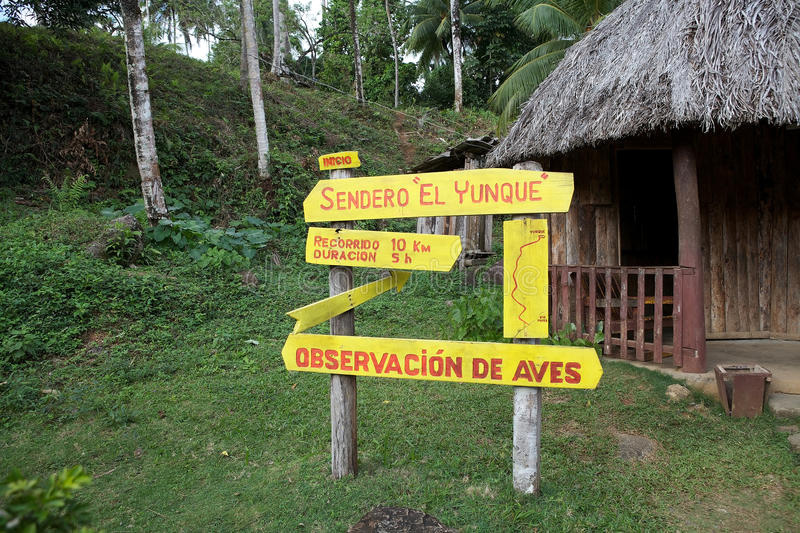
El Yunque offers some of the best hiking experiences in Puerto Rico. You can spend a full day exploring the trails, including the one that leads to Pico El Yunque. Regardless of which trail(s) you choose, sturdy walking shoes are essential. Given El Yunque’s cool and humid climate, it’s a good idea to pack carefully, especially if you’re carrying a camera or other items in your backpack that you want to keep dry.
Pico El Yunque offers breathtaking views of the surrounding landscape and the ocean. From the peak, you can also enjoy distant views of the entire National Forest, including Mount Britton Tower. As one of the highest points in Puerto Rico, standing at just over 3,500 feet above sea level, the peak features an observation tower with a platform perfect for taking 360° photos.
If you spend enough time at the top, particularly in the afternoon, you might experience a dynamic weather system, with wandering clouds, fog, bursts of fresh air, and moments of bright sunshine.
La Mina Falls
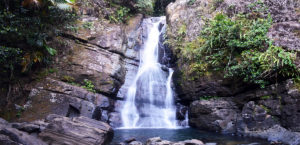
La Mina Falls is the most popular waterfall in El Yunque National Forest. It attracts many visitors daily, not only for its stunning beauty but also for the opportunity to take a refreshing dip in the waterfall pool. Reaching the falls involves a 45-minute walk that descends 0.7 miles through the forest.
Coca Falls
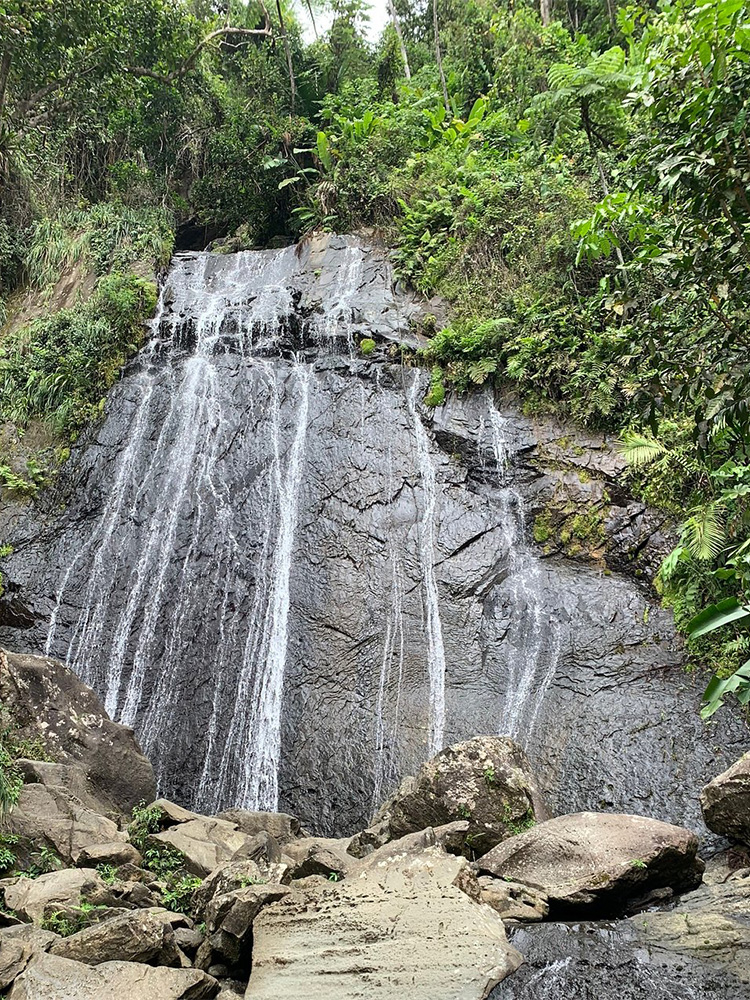
Coca Falls is the easiest waterfall to see due to its convenient location just off the main road, PR-151, about 8 km from the park entrance. There is a small extraction area directly in front of the waterfall. While there are no dedicated parking lots, cars can stop briefly off the road.
The Coca Trail
The Coca Trail is a challenging hike that begins right in front of La Coca Falls. The trailhead is located uphill from the waterfall and requires at least 1.5 hours one way. Most hikes on this trail take approximately 4 hours for a round trip.
The hike is steep and muddy, with several stream crossings. The reward awaits at the end, where you may have the opportunity to jump into a natural well.
Juan Diego Trail
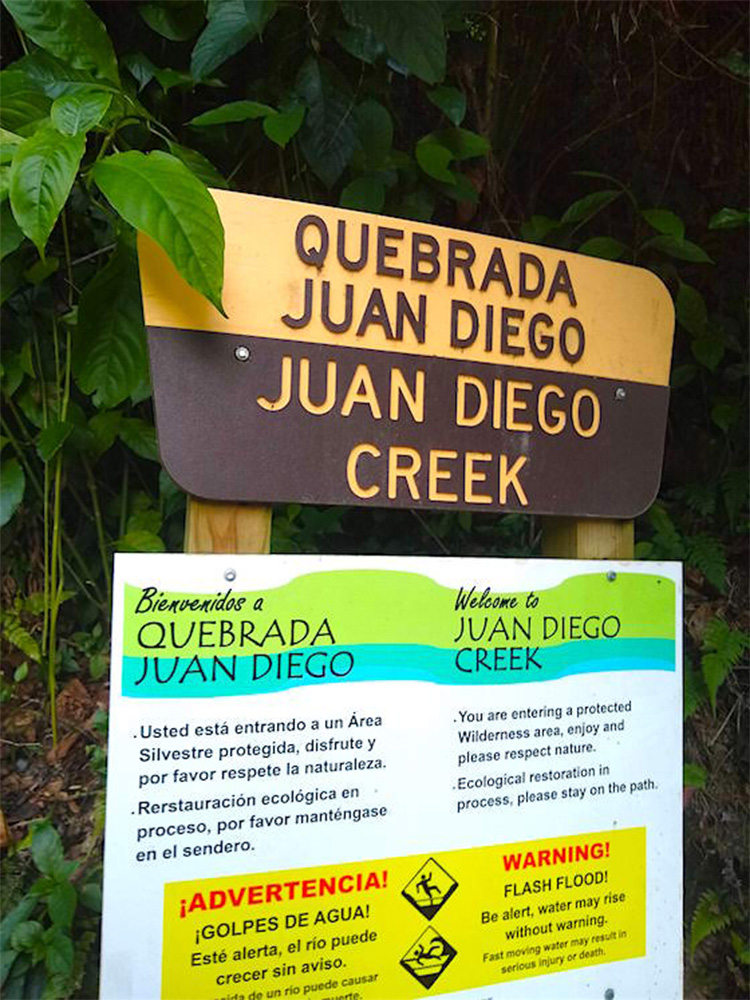
Juan Diego Trail is a relatively easy path that leads to a small waterfall. Once a more isolated spot, it has become a popular stop as one of the few waterfalls now accessible within the forest. Access on this trail is restricted to the lower waterfall.
Juan Diego Creek
Located not far from La Coca Falls, Juan Diego Creek offers an easy walk to the first set of waterfalls and pools for jumping. This area can become crowded, as it’s a common stop for most El Yunque tourist groups.
Consider making this your morning stop and then continuing up the trail to discover more isolated falls and pools. Be prepared for wet, muddy soil and slippery rocks along the way.
Caimatillo Trail
To access the Caimatillo Trail, park on Route 191 at the 11.8 km parking area. The trail begins here and offers a moderate hike through lush tropical vegetation, connecting directly to the El Yunque Peak Trail. Along the way, you’ll experience a variety of flora, including ferns, bromeliads, and native trees that thrive in the rainforest’s humid environment. This trail is suitable for hikers of most skill levels.
Los Picachos Trail
The Los Picachos Trail offers breathtaking views as it branches east from the El Yunque Peak Trail. This short but steep trail leads to a scenic lookout point, providing panoramic vistas of the forest and the surrounding areas, including glimpses of the coastline on clear days. The trail is ideal for photography enthusiasts and those seeking a rewarding view without a long hike.
Baño Grande
Baño Grande is not a waterfall but a large, historic natural pool built in the 1930s as part of a Civilian Conservation Corps project. The area includes a picturesque stone bridge that doubles as an observation point, offering views of the tranquil waters below. Baño Grande is a great spot for a quick visit to appreciate the natural beauty and historic significance of the site. Located further up the road past Juan Diego Creek and La Mina Falls, it is along the route to the Britton Trail. A stop here typically takes about 10 minutes, and parking is available in the nearby Palo Colorado area. Swimming is not allowed in Baño Grande to preserve its ecological balance.
Mount Britton trail
Park on Highway 9938 and follow the route to Route 10 to reach the trailhead. A short walk from the road leads to the Mount Britton Trail, which is a steep and narrow path about 1 mile long.
The hike takes approximately 45 minutes one way, leading to the iconic Mount Britton Tower. This historic stone tower offers panoramic views of the Atlantic Ocean, the Caribbean Sea, and the lush rainforest below. Visitors can ascend a narrow spiral staircase to reach the top of the tower.
After completing the Mount Britton Trail, adventurers can continue to the Mount Britton Spur, which connects to the El Yunque Peak Trail. The trek from the tower to Pico El Yunque, the forest’s highest peak, takes about one hour. Be prepared for changing weather conditions, as the summit is often enveloped in mist.
Mount Britton Tower Spur
This connecting trail links the El Yunque Peak Trail with Route 10, making it a vital route for hikers aiming to reach the top of El Yunque. The spur offers a more secluded experience compared to other trails in the forest.
Palma Sierra
Palma Sierra is a family-friendly area featuring picnic tables, a parking lot, and a food stand offering light refreshments. It’s a great spot for a relaxing break before or after exploring the surrounding trails. The area is shaded and perfect for enjoying the rainforest atmosphere.
Broken Bridge “Puente Roto”
Puente Roto is a popular swimming and picnic area located on Route 988. It features a shallow stream ideal for wading and cooling off, surrounded by lush greenery. The site is accessible to families and provides a tranquil spot for picnicking.
Angelito Trail
The Angelito Trail is an easy and well-maintained path that leads through the rainforest to a small wooden bridge and a serene swimming pit in the Mameyes River. This trail is perfect for families and those seeking a short, leisurely hike. The swimming area at the end of the trail is a popular spot for visitors to relax and enjoy the refreshing water.
El Toro Trail
The El Toro Trail offers a challenging hike to the highest point in El Yunque National Forest, El Toro Peak, standing at 3,524 feet. This trail is accessible from Highway 186 and features rugged terrain that passes through various forest zones, including areas of dwarf forest near the summit. The trail spans approximately 4 miles one way and is known for its steep inclines and exposed sections, making it suitable for experienced hikers.
Most of the hike is in full sun, so bringing adequate water, sunscreen, and a hat is essential. The summit rewards hikers with sweeping views of the surrounding forest, making the effort worthwhile. This trail is less crowded than others, offering a more remote and peaceful experience in El Yunque.
History
The forest region was initially reserved in 1876 by King Alfonso XII of Spain, making it one of the oldest tropical rainforests protected in the Western Hemisphere. Known for its rich biodiversity and unique ecosystems, it was designated as the Luquillo Forest Reserve on January 17, 1903, by the General Land Office. This initial reservation encompassed 65,950 acres (266.9 km²), establishing a foundation for the protection of Puerto Rico’s natural resources.
In 1906, the Luquillo Forest was officially designated as a National Forest by the U.S. government, marking the beginning of federal conservation efforts. On June 4, 1935, the forest was renamed the Caribbean National Forest to reflect its location in the Caribbean region and its significance as a tropical forest.
As part of ongoing efforts to preserve and honor its cultural heritage, an executive order signed by President George W. Bush on April 2, 2007, officially changed the name of the Caribbean National Forest to El Yunque National Forest. This renaming acknowledged the cultural, historical, and spiritual significance of the forest to the Puerto Rican people, particularly its deep connection to the island’s indigenous Taino culture and local traditions.
El Yunque is home to a diverse range of plant and animal species, many of which are found nowhere else in the world, making it a critical area for ecological research and conservation. Today, El Yunque continues to be a vital natural and cultural landmark, attracting visitors from around the world to explore its breathtaking landscapes and rich biodiversity.
Weather
The weather in El Yunque is fairly constant throughout the year. In the summer, the average high temperature is 80°F, with a low of 68°F. In the winter, the average high temperature is 72°F, with a minimum of 58°F. This consistent climate creates ideal conditions for lush tropical vegetation. The rainforest is known for its biodiversity and is home to thousands of native plants, including 150 species of ferns and 240 species of trees. Due to its high elevation and cloud cover, the forest experiences a unique microclimate that helps sustain its vibrant ecosystems year-round.
Ecology and conservation
The ecosystem of El Yunque is specifically managed by the Ecosystem Management Team, under the U.S. Forest Service, to preserve its unique biodiversity and to maintain its vital role in the local water cycle. Due to its location in the northeast part of Puerto Rico, incoming trade winds from the Atlantic Ocean strike the mountains, resulting in recorded annual rainfall of approximately 240 inches (6.1 meters). This process, known as orographic elevation, causes intense rain and the constant presence of clouds in the mountainous region. The persistent cloud cover and winds produced by the adiabatic process of air particles rushing through the mountainside have significantly influenced the morphology of El Yunque. The most noticeable effect has been on the dwarf forest, which is characterized by vegetation that has adapted to these extreme conditions.
The rainforest is home to endemic species of plants and animals, making it an area of great ecological importance. Conservation efforts focus on maintaining its health and integrity, as El Yunque is a vital watershed for the island, providing fresh water to nearby communities. In addition to protecting the biodiversity, restoration projects also aim to mitigate the impacts of invasive species, deforestation, and climate change.
Flora
El Yunque is composed of four distinct forest vegetation zones: Tabonuco Forest, Palo Colorado Forest, Sierra Palm Forest, and Dwarf Forest.
- Dwarf Forest – The largest of the forest zones, the Tabonuco Forest is named for the Tabonuco tree, which is one of the most prominent species found here. It is home to a diverse range of plants and trees, including the Sierra Palm, which is adapted to the region’s rainfall patterns.
- Palo Colorado Forest – This area is known for the towering Palo Colorado trees, which give it its name. It also has a high density of tropical hardwoods and offers habitat for a variety of wildlife species.
- Sierra Palm Forest – This forest zone is dominated by the Sierra Palm, a tree that is emblematic of the El Yunque rainforest. It is particularly noticeable in the higher elevations and provides food and shelter for various species of birds and insects.
- Dwarf Forest – The Dwarf Forest ecosystem, located at about 3,000 feet (910 meters), is the smallest subregion of El Yunque. This forest is characterized by unique vegetation found only in Puerto Rico. The plants in this area exhibit stunted growth, with tree trunks having wider diameters and fewer leaves on their branches than expected. Contributing factors to this stunted growth include high soil acidity, limited soil nutrients, and the persistent moisture in the air.
Fauna
El Yunque is home to a variety of fauna, including reptiles, birds, and amphibians. Its isolation and tropical environment have led to the development of many endemic species found nowhere else in the world.
- Reptiles – There are 8 types of lizards, including the Puerto Rican giant anole, a species well adapted to the forest’s climate.
- Amphibians – El Yunque is famous for its diverse frog population, especially the 13 species of coquís (Puerto Rican tree frogs). These small frogs are vital to the ecosystem as both prey and predators, helping to control insect populations.
- Birds – The forest hosts 50 species of birds, many of which are endemic to Puerto Rico. Notably, the Puerto Rican parrot (Amazona vittata), one of the rarest and most endangered bird species in the world, is found here. Conservation programs are actively working to protect this species.
- Mammals – The only native mammals in El Yunque are bats, with 11 species recorded. These bats play an essential role in pollination and insect control.
- Aquatic Fauna – The forest’s rivers and streams are home to several species of fish, shrimp, and other aquatic organisms, such as the Puerto Rican river shrimp and the native freshwater fish, the Rio Grande darter.
- Snakes – Though rare, the Puerto Rican boa (Epicrates inornatus) can be found in the forest. These non-venomous snakes can reach lengths of up to 90 inches and are important for maintaining the balance of the ecosystem.
Hunting in El Yunque is strictly prohibited, and conservation laws are enforced to ensure the protection of this vital ecosystem.
The Coqui
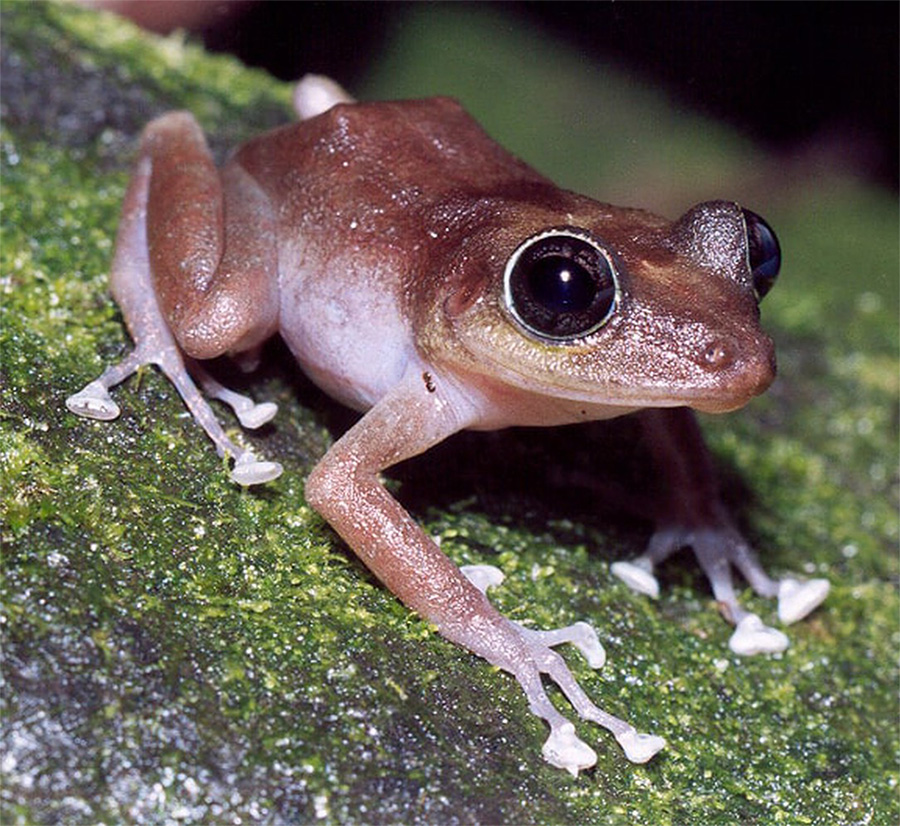
Puerto Rico is home to approximately 16 species of the coquí frog, all members of the neotropical frog genus Eleutherodactylus. Of these, 13 species can be found in the lush environment of El Yunque National Forest.
The coquí is most famously known for the call of Eleutherodactylus coqui, the most common species in Puerto Rico. Its distinctive “co-kee” call, which begins at sunset and continues throughout the night, has made it an iconic symbol of Puerto Rican culture. This nocturnal call is so persistent that it often drowns out other sounds, earning the coquí a special place in Puerto Rican folklore as a beloved creature of the night.
In addition to being culturally significant, the coquí plays an essential role in the forest’s ecosystem. As an insectivore, it helps control insect populations, particularly mosquitoes, contributing to the health of the environment. While the coquí is widespread, certain species face threats from habitat destruction and the introduction of non-native predators, which has led to the need for ongoing conservation efforts to preserve its diverse population.
Puerto Rican Amazon
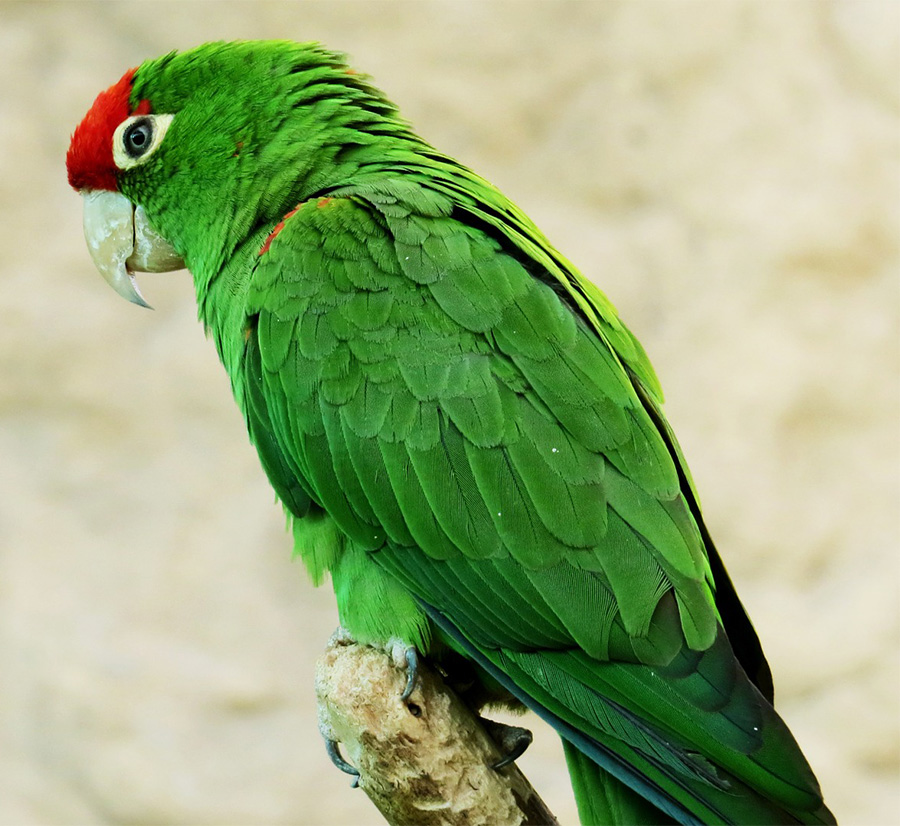
El Yunque National Forest is home to over 50 species of birds, including the critically endangered Puerto Rican parrot (Amazona vittata), one of the rarest parrot species in the world.
This vibrant green parrot, measuring 11.0 – 11.8 inches (28–30 cm), is characterized by its striking red forehead, blue feathers on its wings, and distinctive white eye rings. While once common throughout Puerto Rico, the Puerto Rican parrot’s population has been dramatically reduced due to habitat destruction, hurricanes, and predation from non-native species such as rats, snakes, and mongooses.
In the wild, the Puerto Rican parrot is now confined to small pockets of protected forest, including El Yunque. The estimated population in the wild is between 58 and 80 individuals. In an effort to prevent the species’ extinction, dedicated conservation programs have been launched, including captive breeding and reintroduction projects. These initiatives, along with habitat restoration, have resulted in the successful increase of the captive population, which now exceeds 300 individuals.
The Puerto Rican parrot’s recovery is a symbol of hope for wildlife conservation efforts in Puerto Rico. Protecting its natural habitat and reducing the impact of invasive species remain critical for the long-term survival of this unique and important bird.
The Portal Rain Forest Center
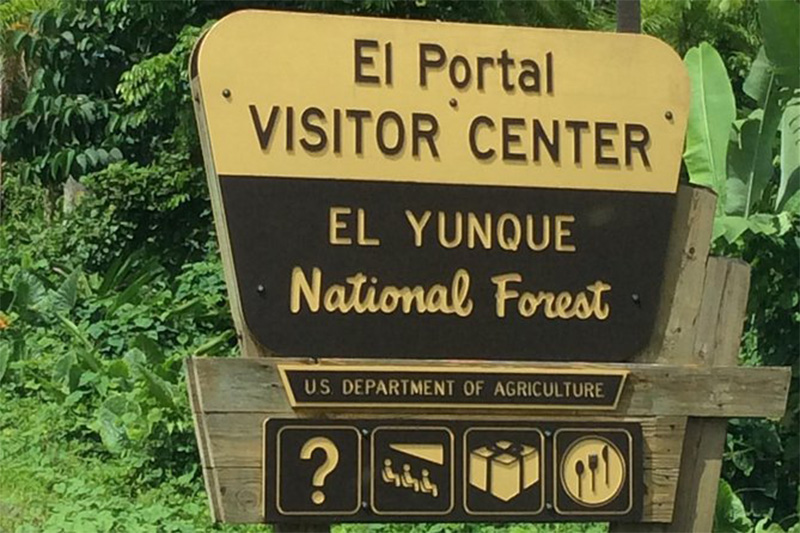
Opened in 1996, the El Portal Rain Forest Center was designed to provide visitors with an immersive introduction to the beauty and biodiversity of the rain forest. The center serves as a gateway for exploring the forest and understanding its role in the region’s ecology.
Built on a 28,434-acre tropical forest, the center was developed as a model for ecotourism, environmental education, and sustainable development. It aims to raise awareness about the Caribbean National Forest’s unique natural heritage and the importance of protecting tropical rain forests.
The entry experience begins at the top of an elevated pathway that connects the facility with the surrounding forest, offering stunning views of mountain peaks, the ocean, and reforested terrain. Visitors can take in panoramic views of the forest while learning about the region’s natural history, flora, and fauna.
The Center spans 9,000 square feet and features educational exhibits, a closed theater, a conference center, classrooms, labs, and administrative offices. Careful attention was paid to the design of the center to minimize environmental impact. Existing roads, parking areas, and buildings were used to preserve the natural landscape, while the arrival sequence and parking lots were carefully planned to protect existing trees and the overall ecosystem.
The Portal has endured several major hurricanes, including Hurricane Georges in 1998. In the wake of Hurricane Maria in September 2017, the center sustained significant damage, and restoration efforts began in 2020. These reforms aim to improve the center’s infrastructure while maintaining its commitment to sustainability and environmental stewardship.
Rates and Hours
El Yunque National Forest is open seven days a week and closes at 6 p.m. The Tropical Forest Center Portal on Route 191 is open daily from 9 a.m. to 5 p.m. The El Yunque Catalina Field Office, located along the road on the north side of the forest, provides information on hiking trails and can assist with planning tours of the forest, including night tours that offer a unique perspective of the rain forest.
While the entrance to the rain forest is free, there is a small fee to access the visitor center.
Camping
Overnight camping is not permitted in the wilderness areas of El Yunque. However, there are designated campgrounds within the national forest. Camping reservations can be made at the El Portal Visitor Center, located on Highway 191 at the entrance to the National Forest. The center can provide information on available campsites and help visitors plan their stays.
How to get from San Juan to the El Yunque rain forest
From San Juan, take Route 26 / Baldorioty de Castro Highway east toward Carolina, then continue onto Route 66 / Roberto Sanchez Vilella Highway. Follow Route 3 east until you reach the intersection with Route 191, a two-lane highway that leads south into El Yunque Rain Forest. Continue on Route 191 for about 3 miles, and as the road ascends, you will enter the rain forest. The address of the visitor center is PR-191, Río Grande, PR 00745.
Be sure to stop at the visitor center for maps and additional information about hiking trails, wildlife, and the forest’s history.
What to Bring
Visitors should bring plenty of water, snacks, and appropriate footwear for walking on trails. If planning to swim in the falls, pack a bathing suit and towel. Insect repellent is highly recommended due to the humid, tropical environment. Additionally, if traveling with children, be sure to bring any necessary items such as sunscreen, hats, or child-friendly snacks.
There is a small shop at the visitor center where snacks, drinks, and souvenirs are available for purchase.
Address and Map:
Physical address:
El Yunque National Forest
PR-191
54 Cll. Principal
Río Grande, PR, 00745/p>
Contact:
(787) 888-1880
sckrupp@fs.fed.us
View Website
High season (May to August)
Low season (September to April)

